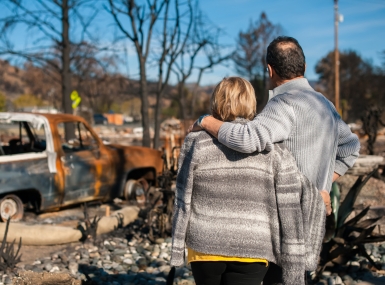Beyond ‘duck and cover’: Preparing for nuclear threats
The emerging nuclear threat has prompted counties to modernize their safety protocols and disaster planning
After a state emergency employee in Hawaii accidentally sent out a false alert about a nuclear missile strike Jan. 13 — leaving residents and tourists scrambling for a panicky 38 minutes before an all-clear sign was broadcast — some county officials might be wondering: “Could it happen here?” And: “Should our county be preparing for a nuclear attack?”
Some counties are thinking beyond “duck and cover,” the old standby from the nuclear threat during the Cold War.
Learn More
In Ventura County, Calif., Public Health Director Robert Levin has been prepping for a nuclear attack since 9/11. “This was a lot of years back, not too long after Sept. 11,” Levin said. “I was listening to the news like everyone else. When I heard Osama bin Laden’s words — that they wanted to terrorize Americans, kill Americans and to hurt us financially, hurt our economy, I realized — because part of what a health officer does is they prepare for terrorism — we had been talking about terrorism with small pox and plague for many months but when this happened, the way you kill the most Americans, terrorize, hurt our economy the most is you knock out a major city with a nuclear device. With that, I decided our county needed to prepare for this.”
‘Get Inside. Stay Inside. Stay Tuned.’
With backing from county leaders, Levin was able to create an 18-page Nuclear Safety Guide, hold town hall meetings, create three public service announcement videos and an emergency plan for all the county’s schools. He knows the plan is a success if residents remember the phrase: “Get Inside. Stay Inside. Stay Tuned.” He’s continued educating the public for more than a decade.
Fast forward to today. With the current political rhetoric between the United States and North Korea, “there is obviously a renewed interest in this, number one, and what we would be talking about here is no longer the size nuclear device that a terrorist might have,” Levin said. “It’s a state-sponsored program, and so their nuclear device would be bigger than that.”
CDC prepping local government
Levin isn’t the only one with nuclear threats on the brain. The Centers for Disease Control and Prevention was set to hold a presentation this week on “Public Health Response to a Nuclear Detonation,” but canceled it due to a nationwide flu outbreak. Presentations that had been scheduled included “Roadmap to Radiation Preparedness” and “Public Health: Preparing for the Unthinkable.” The CDC also held a webinar in August on preparing for nuclear attacks and held an exercise simulating a nuclear blast, dubbed “Operation Gotham Shield,” with FEMA in the New York-New Jersey area last April.
That’s when Middlesex County, N.J. had the opportunity to demonstrate its preparedness efforts with local, county, state, federal, non-profit, volunteer and faith-based organizations. Middlesex County’s objectives for this functional exercise were to hold five training sessions over four days by setting up, operating and demobilizing a Community Reception Center. More than 300 participants from 70 agencies participated.
Since the exercise was conducted, the county’s Office of Health Service has been providing “lessons learned” at preparedness meetings. Middlesex County officials will continue to enhance and update its emergency response plans and continue to meet with local, county, state and regional partners to discuss existing plans and how to apply lessons learned from exercises. Additionally, it is important to educate first responders and the public to ensure that everyone is prepared to respond and recover from an emergency, according to John Dowd, division head, Health Education and Emergency Preparedness, Office of Health Services.
Dowd teaches a two-hour course on the basics of radiation and what to do during a radiation emergency. The course covers sheltering in place, self-decontamination and ways to stay informed during a radiation emergency. Responders learn the basic operation of radiation detectors, dosimeters, portal monitors, personal protective equipment selection and decontamination procedures.
Dowd also trains emergency responders to operate monitoring stations to perform population monitoring and contamination reduction measures after a radiological or nuclear incident. The CDC’s Christine Kosmos, director, Division of State and Local Readiness, has said that population monitoring is one of the most challenging responsibilities for local government in any nuclear or radiation incident.
Matt Ansorge, Emergency Management director for Leelanau County, Mich., said although a nuclear incident is not a “prominent threat” for his county, he touches on it during talks to the public, especially about the importance of preparing to shelter in place and purchasing plastic that can be duct-taped to windows.
Some areas of the country, especially the West Coast, feel more vulnerable to an attack. In September, the Washington Senate State Government Committee met at the King County Emergency Coordination Center to discuss disaster preparedness in the event of a nuclear attack. Emergency managers in the Evergreen State are currently prohibited from preparing for a nuclear attack, thanks to a 1984 law (passed in part to mark the winding down of the Cold War) making it against state policy for emergency managers to prepare for evacuation or relocation in case of a nuclear attack. A state lawmaker may reintroduce legislation to change that; it failed last year.
Could a false alert incite panic in your county?
In Hawaii, residents and visitors on Jan. 13 panicked after getting this message: “Emergency Alert: Ballistic missile threat inbound to Hawaii. Seek immediate shelter. This is not a drill.”
“My heart instantly went out to the person who sent that message, I knew there was some kind of miscommunication,” said Ansorge, the Emergency Management director for Leelanau County, Mich. “In the same breath, there was mass hysteria.”
Could it happen in your county? Gregg Bird, PEM, NEMAA, emergency management coordinator, Grand Traverse County, Mich., said that in his county, “without proper training, yes it could. We ensure that those that have access to our system have plenty of training and continuing training on the system.”
Bird advises all counties to have proper training and continued regular training on your system. If you’re using pre-staged messages, try to have them easily distinguished between ‘real’ and ‘tests,’” he said.
If the worst happens, and your county sends out an alert in error, what should you do? “Immediately issue a corrected message,” Bird said.
Ansorge echoed those sentiments. “If we did have some sort of false alarm, we would have to immediately communicate through several mediums and multiple emergency managers. The last thing we want is for the general public not to trust the messages that come out next time.”
Attachments
Related News

HRSA Releases Final Reentry Care Guidelines Following NACo Input
On November 29, the Health Resources and Services Administration (HRSA) released their final Policy Information Notice (PIN) with policy guidance for health centers who support transitions in care for justice-involved individuals reentering their communities.

House Transportation and Infrastructure Committee advances, House passes key bill with NACo’s support
On September 18, the U.S. House of Representatives Committee on Transportation and Infrastructure held a full committee markup session, voting to advance 29 measures for House floor consideration.

Congress advances Second Chance Act reauthorization
On December 4, the Senate passed the Second Chance Reauthorization Act (S.4477) by unanimous consent, a major milestone for supporting county reentry programs. NACo supports this legislation, which would reauthorize funding for Second Chance Act programs for five years.
